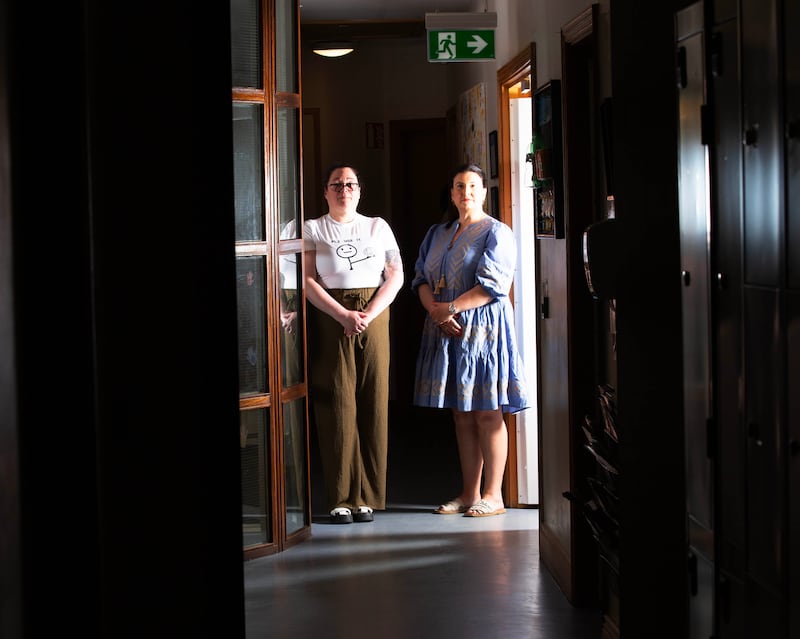Two young women contacted the Sexual Violence Centre in Cork last week with concerns; a man had taken to driving up and down the cul de sac where they live, almost every evening.
“He stops outside their house for about 10 minutes and drives on,” said Mary Crilly co-founder of the Sexual Violence Centre.
The man is a stranger to the two flatmates who have no idea what has provoked the stalking, she says.
“It is only a matter of time before he will up his game,” she says. “They fear the time that he is going to not just park outside the door, but come in. And that will happen.”
Those who help people targeted by stalkers point to other examples.
Natalie O’Reilly, the domestic violence coordinator at Longford Women’s Link, which helps women in the county, says the gym and hair or beauty salons are becoming regular haunts for people who want to track former partners after a relationship breaks down.
“If he is turning up at your gym, he controls you because you are not going back to that gym. Your world gets a lot smaller,” said O’Reilly.

In another example, one woman she helped fled the gym through the fire escape at the back after seeing a former partner arrive at the front door “looking angry” with no kit and no apparent intention of working out.
“He saw her car outside. If anyone challenged him he would say he was there to join up.”
The acclaimed Netflix TV series “Baby Reindeer” – based on its creator Richard Gadd’s own experiences – has put stalking in the spotlight, documenting the devastating impact on, in this case, a male target. The recent introduction of new legislation in Ireland, making stalking a stand-alone offence with a maximum sentence of 10 years, has also focused minds.
O’Reilly points out that advances in technology mean stalking has become much more sophisticated than “just someone hiding in the bushes outside your door”.
“Perpetrators don’t have to be hiding in the hedge now or following the target in the car,” she says.
“Smart homes are so problematic; you have cameras, the ring video doorbell where from anywhere you can monitor a conversation happening on the doorstep. Every phone has a tracking device on it.”
Smart speakers such as Amazon’s Alexa and even baby monitors are “all being used to monitor – and that is stalking,” she says.
Sonya Fitzmaurice, O’Reilly’s colleague at Longford Women’s Link, says stalking regularly takes the form of simply turning up everywhere the target is, whether that is in the supermarket or at the GAA club when the children are training.
“If a woman goes to the shop or for a takeaway, he can legitimately sit outside in a public car park, while letting her know he is tracking her,” she says.
She points to another example of a woman last week shopping at a Lidl supermarket. Her former partner from a relationship that ended several years earlier drove into the car park behind her, followed her around the supermarket and went to the same till.
“He bought one item. He never said a word to her,” she says.
Since the new legislation was enacted in November, campaigners believe both targets and gardaí will feel more empowered to deal with behaviour that can escalate to physical and sexual assault and in some cases murder.
Tara Farrell, chief executive of Longford Women’s Link, says that the vast majority of the 300 or so cases of domestic violence the centre dealt with last year had a some element of stalking.
I know of one girl who had to leave a rural area because the person stalking her was very popular and the attitude was that ‘he would not do that’
— Mary Crilly Cork Sexual Violence Centre
The group set up an inter-agency forum comprising local gardaí, HSE staff and other frontline workers to co-ordinate a response to domestic abuse. It hosted a two-day training workshop last year with Prof Jane Monckton Smith who has developed an eight-stage homicide timeline, setting out identifiable stages in which coercive relationships can escalate to murder.
“We delivered training to 140 frontline responders from six agencies”, said Farrell who pointed out that stalking features prominently in the British expert’s eight stages of homicide.
Dr Ciara Staunton, co-author with Dr Catherine O’Sullivan of a University College Cork study on stalking, carried out in conjunction with the Cork Sexual Violence Centre, says that when convictions start to be recorded, it should indicate how widespread the offence is, though last year’s research gave a startling signal.
The authors were taken aback when, after putting out a call for people who had experienced stalking, they received more than 1,000 responses.
“I thought maybe we would get 20 to 30,″ says Dr Staunton, a forensic psychologist.
She found the Baby Reindeer series “a hard watch”, noting that it was less typical in that it was a man being targeted by a stranger.
Of the 892 cases analysed by the UCC team, 9 per cent were male and 257 of the perpetrators were strangers with the majority – some 468 – partners or former partners, while 206 described their stalkers as “acquaintances”. Some 131 were described as “friends” and 107 as work colleagues.
The impact of the behaviour was devastating with 750 respondents reporting anxiety, 265 saying they had suicidal thoughts as a result, 148 reports of self-harming and 92 suicide attempts.

Typical behaviour included sending inappropriate texts, emails or WhatsApp messages (623 cases); unwanted approaches and being followed (509 each); the perpetrator loitering outside the target’s home or other places (507) and being spied on using technology (506).
“It is about power and control. It is about terrifying somebody,” said Mary Crilly of Cork’s Sexual Violence Centre.
She was not surprised at the huge volume of responses the researchers received given that 800 people signed up for a webinar on stalking the Cork Sexual Violence Centre hosted during the Covid pandemic.
Since the Crime Victims Helpline started referring stalking cases to the Cork centre about a year ago, they have been receiving two to three reports a week.
She knows of people who have had to leave their jobs and the area where they live due to stalking.
“I know of one girl who had to leave a rural area because the person stalking her was very popular and the attitude was that ‘he would not do that’,” she says.
“But the perpetrator grooms not just the victim but everyone around them. He will say ‘I did nothing. I just called in to see if she wants help with the garden’.
“So people end up for the sake of their mental health moving away. And very often they don’t get away because if he wants to keep control he will finds ways of doing it”.
Crilly too has watched “Baby Reindeer”.
“I thought it was great for raising awareness. It showed how difficult it can be to get out of it, how delusional the other party can be,” she says.
“But we found that a lot of the people we meet have worn a path into the gardaí.”
Crilly says the show reflects how people worry about offending the stalker or initially feel sorry for them.
“Initially, they might think they are over-reacting. They don’t want to be rude,” she says.
Sarah Benson, chief executive of Women’s Aid, says stalking can sometimes take the form of “love-bombing”; for example, where the perpetrator leaves flowers at their target’s home every single day, or constantly sends them gifts. Responses to such sinister behaviour can be unintentionally minimising, she says.
Victims will tell us that their friends or guards will say: “Ah sure, wouldn’t I love to get flowers.”

But the unwanted flowers and gifts show an “obsessive focus” that can escalate to serious sexual assault “and even murder”, she says.
She welcomes the new legislation which was informed by the campaigning of Una Ring and Eve McDowell, two women whose ordeals at the hands of stalkers who were subsequently convicted, allowed them to push for a change in the law.
But Benson says one measure – “arguably the most important one”, which has been passed but not yet enacted – is crucial because it provides protection for those targeted by non-partners.
“If the perpetrator is a current or former intimate partner, you may use the domestic violence legislation to seek a protection order but where there was not an intimate relationship, there is no civil restraining order available. It is in the law but has not taken effect,” she says.
A spokesman for the Department of Justice said that the bulk of the provisions in the legislation were commencedfrom November 1st, 2023 by Minister for Justice Helen McEntee.
He said that part 5 of the 2023 Act, which provides for the system of civil orders, “is yet to be commenced” as these provisions are subject to further preparations by the Courts Service.
“But this work is well advanced,” he said. The spokesman said the Minister expects to formally set the date on which these provisions will come into operation shortly.
- Sign up for push alerts and have the best news, analysis and comment delivered directly to your phone
- Join The Irish Times on WhatsApp and stay up to date
- Listen to our Inside Politics podcast for the best political chat and analysis













